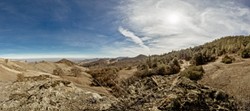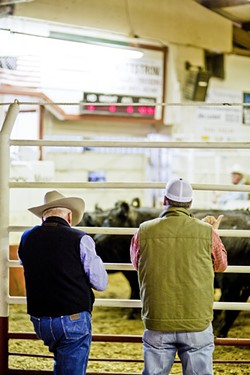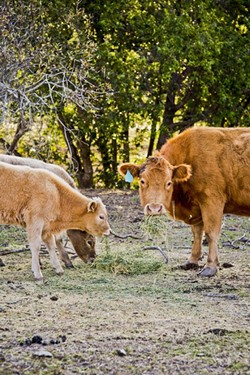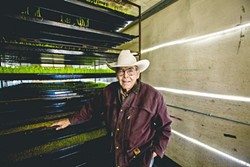[{
"name": "Ad - Medium Rectangle CC01 - 300x250",
"id": "AdMediumRectangleCC01300x250",
"class": "inlineCenter",
"insertPoint": "8",
"component": "2963441",
"requiredCountToDisplay": "12"
},{
"name": "Ad - Medium Rectangle LC01 - 300x250",
"id": "AdMediumRectangleCC01300x250",
"class": "inlineCenter",
"insertPoint": "18",
"component": "2963441",
"requiredCountToDisplay": "22"
},{
"name": "Ad - Medium Rectangle LC09 - 300x250",
"id": "AdMediumRectangleLC09300x250",
"class": "inlineCenter",
"insertPoint": "28",
"component": "3252660",
"requiredCountToDisplay": "32"
}]
In the early midwinter morning, Dick Nock drove his Jeep Grand Cherokee up a dirt road to a hilltop where a small group of cattle lingered like they were expecting him. As he slowed to a stop, the cattle gathered around the vehicle, staring inside, and started to moo. The mooing continued, incessantly. They were hungry. Then a pickup truck loaded with hay came over the horizon on the next hill, and the cattle didn’t hesitate before they ran toward the truck, joining other members of the herd that came running from another direction.
Nock’s ranch-hand tossed bunches of fading green alfalfa hay from the truck, smattering the brown ground before the cows quickly chomped on their daily ration. The sight was indicative of the situation facing the cattle industry in California and the West, where things are upside down, or as Nock said, “off kilter.”
Asked about the specifics of running cattle in a drought year, Nock—wearing his signature wool cardigan, collared shirt, and tan cowboy hat, let out a sigh, shook his head, voiced a long “well,” and simply said, “There’s no feed.”
That’s the bottom line: There’s no feed. To supplement the grass that should be on the ground but isn’t, Nock has been spending $500 a day on hay to feed the cattle on the three different ranches that he leases along parts of the Santa Lucia Range. Nock’s currently at 50 percent of normal herd size. The 82-year-old rancher was born in Cambria and has been in the cattle business his entire life. He’s seen droughts, but none quite like this.
It was Jan. 31, a time of year when the hills are normally anything but faint barren brown. Throughout California, those in the deeply rooted agriculture industry knew that not only was it bad, it was dire. The year 2013 went down as the driest year on record in the state, and by the end of January—the halfway point of the rainy season—it still hadn’t rained. Some reports even put this as the driest period since the hooves of cattle first touched ground after being brought by the Spanish in the 1700s. The truth that the West is one big desert was rearing its head.
Then, in February, the month everyone hoped would bring relief, water started falling from the sky. After the first few rains, Nock got about 2 inches in Morro Bay and 4 up the mountain from Cambria. He was lucky—the coastal areas, especially up at the top of the ridge, see more rainfall than other parts of the county. The farther inland you go, the less it rains. In the eastern part of the county, near Shandon, there was just a bit shy of an inch. To the north, Parkfield saw just more than an inch. While it wasn’t much, it was a start, and eventually the ground showed a green tinge of grass, a shade so light your eye could feel it but couldn't quite make it out, like the static along the screen of an old tube television set. As February progressed, so did the green grass.
But for many in the business, the damage is done. For others, the rain may or may not bring salvation. While the hills may be green, grass must be at least an inch tall before cattle can get to it with their teeth, so for now, the grass is just a tease.
“They can see it, they can smell it, but they can’t eat it,” said Tim Koopmann, rancher and president of the California Cattlemen’s Association, speaking at the SLO County Cattlemen’s Association annual meeting Feb. 13.
* * *
What makes cattle ranching unique, and at times vulnerable, is its direct dependence on rainfall for production. Some agriculture can irrigate, some can’t. For ranchers, as well as the few remaining dry farmers in the area, it’s all a matter of rainfall. There is some irrigated pasture, but it’s minimal. This puts the industry in a tenuous relationship with Mother Nature.
When dry periods come, heavy decisions follow. How exactly ranchers adapt is the million-dollar question, says Kevin Kester.
Kester, a fifth-generation rancher—his great-great-grandfather, William B. Kester III, was a county supervisor in the 1890s—runs cattle on the family’s 22,000 acres near Parkfield in Monterey County. They run a stocker operation, purchasing young steers (castrated males) in the spring when they’re calves, and sending them to roam and gain weight, aiming for a 250-pound target gain. Then in late spring or early summer of the next year, the cattle is sold to a feed lot, where they are kept for another 120 to 150 days until slaughter. Kester has several hundred head of cows (females that have given birth) and normally purchases several thousand yearling stocker steers.
After a dry winter last year, there was little grass growing last spring, so Kester simply didn’t buy any steers. In the summer he sold off the older end of his cow herd in order to lighten the impacts on the land, which allowed him to stretch the existing feed and limit the costs of hay. This has been a common practice throughout California, where the best part of the herd is kept in hopes of holding out until greener pastures come.
Not everyone could hang on though; some ranchers have had little option but to liquidate entire herds. Kester knows at least five people who have done so, and echoes of the measure rumble throughout the county. New Times tried to track down a rancher who sold off an entire herd, with no success—it’s a sensitive subject, and those asked about it were unwilling to reveal the names of ranchers in this predicament.
But for many cattlemen and women in the area, they’ve been able to hold on, for now. Nock is among many who run a cow-calf operation, where heifers (females yet to give birth) and cows are kept to birth calves, eventually weaned off and sold to stocker operations like Kester’s. Male calves are sold, as are some female calves, while some heifers are kept to replace older cows with declining productivity. Cows are the backbone of the ranching industry.
“A cow is a factory,” Nock said. “It’s hard to replace that factory.”
As cattlemen have weathered the storm, cow-calf operators like Nock, who normally cull their herd annually by about 20 percent, have cut back drastically, selling older cows, cows that didn’t give birth, and cow-calf pairs if the calf isn’t yet ready to be weaned off, or splitting them up early.
Cattle are sold in many arenas, including Templeton Livestock Market. Usually this time of year, the market is open every other Saturday, but all winter it’s been open, and busy, every Saturday. Beth Baxley, who owns the market and another in Visalia with her husband Randy, said that currently they are doing about four to six times more business than normal.
On one Saturday afternoon, sitting in his normal seat at the top row of the dusty wooden bleachers, in the center seat looking straight down the aisle and right into the ring, Nock explained the inner workings of the auction piece by piece whenever there was a moment’s break from the quick, rhythmic drone of the auctioneer. In addition to raising cattle, Nock is also a cattle dealer, or an order buyer, who buys cattle for various customers. He’s also a ranch Realtor, and a spokesperson for the local Cattlemen’s Association. He has a keen ability to boil down complex layers of the business into simple terms, and in the process rattle off numbers and statistics that demonstrate the many factors at work in the bigger picture.
At the market, a handful of buyers watched from their normal spots, sitting in the same place they did last week, and do their work. Cattle bought there will be shipped all over—the older cows may go straight to slaughter, called a terminal cow, or to a feedlot first. Some go north, some east. Cow-calf pairs are sold together, sometimes split up if the calf is ready, which will bring in more money than keeping them together. The calf may go to Texas, the mother to a feedlot. Currently, large numbers of cattle are going to Texas, where ranchers there are looking to recover as a drought in that state tails off. Some may go up to another state, some to the Central Valley.
In some ways, the demand for cattle in Texas has been a saving grace, with an added upside—cattle prices are high. Recently on the commodity market, live cattle futures were a hair more than 1.44, the highest they’ve been in 30 years. Nock said because other places in the nation are looking to recover, a calf weighing 300 or 350 pounds, considered very light, is bringing in as much money as a 700-pound calf did last year.
This also means cattle are being sold off earlier than normal, which may place a strain on the supply in the future. That’s a concern for Jason Glenn, an order buyer with B&G Cattle Company.
Glenn is one of the more active and animated of those at the auction, found leaning against the metal rails of the ring with a front row seat. He’s visibly comfortable there—turns out he used to work at the market, where outside behind the building a crew moves cattle from the pens in the back, in and out of the auction ring. It’s an impressive sight, run like clockwork. A few cowboys and cowgirls on horseback run the cattle up and down the corral, others ride the gates as they open and close, and two more stand in opposite sides of the ring to steer cattle in and out. Glenn, originally from Northern California, worked at the auction to put himself through Cal Poly.
Glenn will buy cattle to be sent off to feedlots in Colorado, or to pasture or a feedlot in Texas or elsewhere. He said when the drought in Texas started, cattle were going in the opposite direction.
“We were down there buying all their cattle and bringing them out this way, and now they’re out here bringing the cattle out that way,” Glenn said.
Currently the getting is good, but Glenn wonders how long that will last. Because some stockers didn’t run steers last year, and cow-calf operators are selling off early, with a supply culled on the front end, leaving potential for a supply shortage on the back end. Down the road, herd sizes will be smaller than normal, and it will take a few years for the numbers to bounce back, especially as cow-calf operations work to breed their herds back, taking anywhere from a couple of years to a decade.
“We’ve got a drought problem, and then we got a supply problem,” Glenn said.
That’s where supply and demand kicks in—demand for beef is steadily growing while supply shrinks. It has at least brought a good market, but the high prices also reflect a higher cost of production. Glenn admits that with all of this, those in the industry will need to adapt, which doesn’t always comes easy with a demographic that is at times set in its ways. The land underneath the Templeton Livestock Market is undergoing a changing of hands, sold off for the new owner to raise houses. Meanwhile, Glenn plans to open up a market in Hanford.
“I think the bigger concern is where do we go from here; it’s not where can we go to survive the storm when the storm’s over, but where can we go at the end of the storm,” Glenn said.
* * *
One way to measure the amount of cattle in production is by the number of calves. According to the National Agriculture Statistics Service, a service of the United States Department of Agriculture, the annual calf crop has declined—there were 36,152,500 head of calves in the United States in 2008, and 33,930,000 in 2013. In San Luis Obispo County, the total head of cattle has declined from 157,000 in 1975 to 55,000 in 2013.
By Nock’s estimate, the cattle population in the United States is at its lowest point since 1951. Many factors are at play: Urbanization and rural sprawl has swallowed some rangeland; land has been converted to other forms of agriculture—in SLO County, often to grapes; in the Central Valley to nuts, grapes, or other cash crops; fewer people are pursuing agriculture globally, with younger generations less likely to carry the torch. Regulations have made running a ranch, or a feedlot or slaughterhouse, more expensive. As the old guard hangs its years on a hook, high land prices make it hard for the new to get in.
Around here, in the land of astronomical property prices, many lease land, and those who own the land likely inherited it. Many ranchers have day jobs, or have diversified their income. Some smaller producers have a day job and run a few head of cattle on the side. For most in the business, it’s a lifestyle and a labor of love, much more than it is a labor after riches. It’s one example of the term “cash poor, land rich.”
For Steve Sinton, a prominent member of the local agricultural community, owning land and staying diverse is crucial. Sinton has a diversified operation. After returning home from a 20-year career practicing environmental and water law, Sinton runs cattle, grows wine grapes, leases land to farmers, and manages commercial rental properties in town. His son is involved in the businesses, and one day will likely take over.
“The infrastructure to get started in the cattle business is just ridiculous,” Sinton said. “People who usually come in are people who made money elsewhere and have lots of money. It’s not the Cal Poly grad who has an ag background and gets a little piece and gets started.”
The Sintons have reduced their herds by 75 percent, leaving only replacement heifers and first-calf cows. Luckily, they aren’t dependent just on the cattle.
“We’re so close to breaking even that almost anything would make a difference,” Sinton said.
One source of support many use is a conservation easement—in which a nonprofit or a trust pays a landowner to place land under an agreement that prohibits development for perpetuity.
A focus on conservation and stewardship tends to produce a different philosophy of rangeland management. In times of drought, it may mean a more prolonged ability for herds to feed, but this year and last however, it’s so dry it doesn’t matter.
“This year is the exception to the rule,” Sinton said. “I would say that people who manage conservatively and leave grass behind have had a cushion the last two years, but I don’t think anybody has had a cushion this year, because there was never that moment where we turned the corner.”
Kester underscored the severity seen this year.
“The current drought would be a disaster by itself, but add in the prior two years, it’s never been this bad since there’s been cattle in California,” Kester said. Kester mentioned a Berkeley study that has calculated California rainfall patterns over the past thousand years, which found that it has been 480 years since a three-year dry period like this one.
“We just have to try to figure out what the pattern is going to be, whether it’s a short-term pattern or a 20- to 30- year pattern,” Kester said.
When the state or federal government declares a drought to be a disaster, government assistance programs kick in. Kester, who was recently named vice chair of the National Cattlemen’s Beef Association policy division, has long been involved in the policy and politics of ranching. He explained that, luckily for ranchers, these emergency programs were kept intact in the recently passed Farm Bill, which puts $956 billion into play to fund food and agriculture programs, setting policy across the nation. Included are low-interest loans for crop insurance programs, and conservation incentives.
Because it is still mid season, and most ranchers are at the cusp of where the remaining herd may see some green grass coming, it’s too soon to tell how extensive the damage has actually been, said Val Dolcini, California state executive director of the USDA Farm Service Agency, which oversees the administering of the programs. But, Dolcini said that so far the programs are in gear, and it’s going to be a busy year.
“It’s really going to be a full year of drought-related activity from the perspective of my piece of the USDA,” Dolcini told New Times.
* * *
There are a few operators around who have gotten creative, like Jack Varian. The Varians have a lodge and cafe in Parkfield, which features their V6 Ranch grass-fed beef, and every April they lead a cattle drive that starts at their 20,000-acre ranch north of town, takes the cattle right through town, and to an irrigated, permanent pasture Varian keeps south of town. Because his ranch sees low rainfall, he chose to supplement the cattle with the irrigated pasture, where he uses an intensive grazing practice called mob grazing, where dense numbers are kept in a small area for a short time before being moved over. This method, Varian says, emulates how herds of buffalo would graze in the wild and allows the grasses to return fairly quickly. It is all part of his dedication to holistic management.
Because he raises grass-fed beef—which never goes to feedlots for finishing—the options for supplemental feed are limited, which led Varian to pursue another food source: fodder, or sprouts. Varian purchased six semi-trailer refrigerator units that were no longer road worthy, and converted them to hydroponic grow rooms, where barley seed is sprouted to grass in large black trays. Because he can’t feed his cattle grain, he turns it into grass, and multiplies his yield doing so—five pounds of barley seed produces 35 pounds of fodder. As far as New Times could tell, Varian is one of two grass-fed beef operations that use the method in the area. While the jury is still out on how nutritious it is as a food source—the moisture content may be so high that cattle will get full before satisfying total nutritional needs—and whether it’s cost effective, Varian sees it as just one piece to the puzzle.
“I’m a believer in the saying ‘the whole is greater than the sum of the parts,’” Varian said. The idea is the removal of the moving parts, creating a more stable platform for his operation.
“Rather than go buy more land, well, why not produce your needs in a more confined area?” Varian said, recognizing that at this point, the fodder production is a “grand experiment” that he deeply hopes will work.
There’s another part to his holistic ideals—acknowledging the fact that these days, you can’t depend on the cattle alone.
“If your income comes totally from cattle operation and that’s it, I think you’ve got a problem,” Varian said. “I don’t think you can depend on your cattle paying all the bills year in and year out.”
During a drought at the beginning of the ’90s, Varian said he went and saw City Slickers—a Western comedy staring Billy Crystal, where a couple of New Yorkers go on a cattle drive in the southwest—and came away from the film with some ideas. The Varians now have a hunting club on their ranch, as well as horse trail rides, camping, and the cattle drive. They also have a conservation easement on the property. The next step for them is figuring out how to best sell their beef in a direct market.
* * *
It’s raining as this article goes to press.There may be some relief yet, but how much, and how that plays into Mother Nature’s alchemy when it comes to grass production, is, as lifetime rancher Nock says, “for the birds.”
On Saturday, Feb. 22, the Templeton Livestock Market was still a busy place, even though more rain is supposedly on the way. It’s an indication of just how behind things are on the ground, a story that will have to wait to be told until the season is over.
After the Feb. 13 Cattlemen’s Association meeting, New Times asked cattleman and grape grower Sinton a question explored during interviews for this story: Will this drought become a transformational factor in local agriculture? To that question, Sinton, like many others, showed a sort of attitude common among cattlemen that demonstrated a willingness, and the dedication, to weather the storm.
“This is a resilient bunch,” Sinton said. “So most of the people in this room will get back at it when they can.”
Staff writer Jono Kinkade can be reached at [email protected].
-- Melody DeMeritt - former city council member, Morro Bay
Latest in News
Readers also liked…
-

Coast Unified teachers upset over new position's salary and qualifications
Oct 20, 2022 -

SLO police identify alleged driver who hit and killed couple
Dec 22, 2022 -

When the levee breaks: Oceano residents, county officials walk a tightrope of regulations to manage Arroyo Grande Creek, which some say led to the levee's failure in January
May 18, 2023










